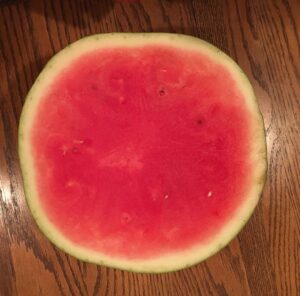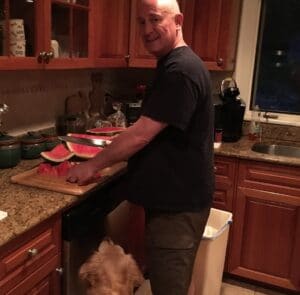Hello Fellow Readers, We attended a pool party over the weekend with close friends; the host is a full-fledged organic gardener. “Aren’t seedless watermelons genetically modified not to have seeds?” one guest whispered as we dished the delicious fruit. “How can it be organic?” Which recalls a column from years ago.
The little white thingies are seeds.
Summer picnics bring back memories of seed-spitting contests. Hard to do nowadays as most watermelons are said to be seedless, but the truth is, it’s not so. Those little white thingies among the watery pink fruit are infertile seeds. Sure, they’re digestible. But so are the traditional black seeds if you’re so inclined. And both won’t cause a watermelon to grow inside your tummy. I still giggle over Mom’s warning, which backfired and inspired me to eat more seeds.
The good news is seedless watermelons are not genetically modified organisms (GMOs). Designing seedless fruit has been in fashion for a very long time. Cuttings of adult grape plants are rooted in soil to produce seedless grapes, which began over 2,000 years ago. In other words, the grape plants aren’t grown from seed and are clones of the mother plants. And while they create seeds of sorts, a genetic slipup doesn’t allow them to form fully.
 Seedless watermelons are much like mules.
Seedless watermelons are much like mules.
Making seedless watermelon, popular since the ’90s, is a different process. Much like horses mating with donkeys to produce mules, seedless watermelons are hybrids–a mix of two species or varieties of plants or animals. Two mules cannot make more mules as they are sterile. The same is true of seedless watermelons.
The common watermelon (a diploid watermelon) has two sets of chromosomes. Colchicine (pronounced kowl-chuh-seen) from the autumn crocus plant is used on seeds causing the plant to grow four-chromosome flowers. By pollinating a four-chromosome flower with a two-chromosome flower, an infertile watermelon with three chromosomes called a triploid is born.
It sure sounds fishy; that changing the number of chromosomes isn’t considered genetically altering. But a GMO uses genetic engineering to alter DNA. (DNA stands for deoxyribonucleic acid, the molecule comprising organisms’ genetic code.) While a chemical from a different plant, the autumn crocus, creates a chromosomal change in the original seed, no genes from other organisms are used to modify a watermelon’s DNA. In other words, genes are not manipulated to create seedlessness.
The oxymoron of watermelon
So, how do you grow seedless watermelons if they don’t have seeds you can plant? It sounds like an oxymoron. (I adore that word, which means self-contradictory.) You’ll need to grow four-chromosome seeds and two-chromosome seeds next to each other so that when they flower, they can cross-pollinate and produce watermelons with three chromosomes making them seedless. And yes, you can grow seedless watermelon organically by not using pesticides or chemicals.
It isn’t easy to explain, and I’m hardly an expert. I’d still like to spit watermelon seeds for old times’ sake. But I’ve outgrown the curiosity of what happens when you eat the seeds. Maturity sometimes changes the magic. Bittersweet (yes, indeedy, another oxymoron). Garden Dilemmas? AskMaryStone@gmail.com and your favorite Podcast App.
Enjoy more to the story in the Garden Dilemmas Podcast:
A helpful article on explaining GMO vs. Non-GMO Seeds
Click through to a previous column The Magic of Seeds
Column updated 6/13/23



